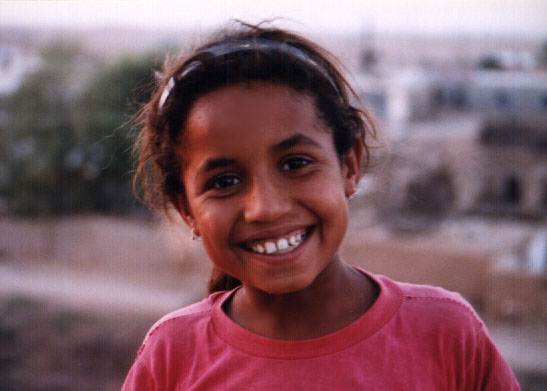

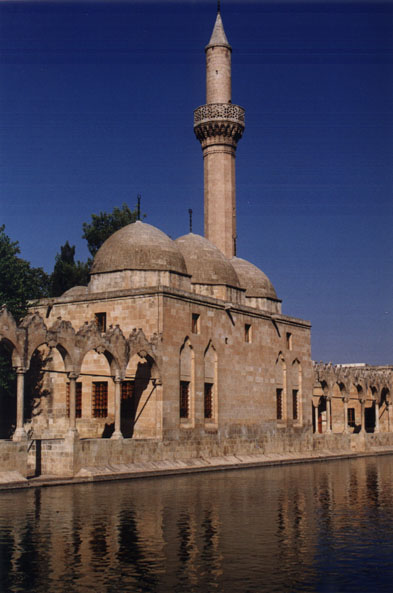 |
| Abraham's Pool, Urfa |
Late morning and afternoon of Saturday, September 4.
My early morning attitude problem quickly passed as we sat down to a hearty Turkish breakfast at the hotel. Susanne and Maggie went back upstairs to shower while Michael and I lingered over a second cup of tea. Michael made a concerted effort to order some milk for his tea but the wait staff couldn't comprehend why he would want to ruin his morning beverage with it. After finishing our tea and gathering our belongings, we met Özcan and Ali by the bus and departed south for Urfa. Within five minutes, though, we were forced to turn around when Ali realized he had left his bag back at the hotel.
"No excuse!" Özcan chided him playfully. "You were the only one of us who got to sleep in late, and yet you still forgot your bag!"
By 10:30am we were back on the road to Urfa, leaving behind Kahta's mountains and valleys in exchange for the scorching hot plain of Upper Mesopotamia. The drive would normally take around two hours, but we stopped briefly at Atatürk Dam. One of the largest dams in the world, Atatürk Dam is the showpiece of Turkey's Southeast Anatolia Project, also known by its Turkish acronym, GAP. A symbol of Turkey's technological prowess, GAP is a bold attempt to irrigate the parched lands of southeastern Anatolia, from Gaziantep to Diyarbakir. The Atatürk Dam, finished in the early 1990s, is one of 22 dams that will be in place by 2005. Once complete, GAP will divert waters from both the Tigris and Euphrates rivers to quench three million hectares of land. The project will transform the region from arid desert to fertile cropland, creating as many as 1.8 million new jobs in the process and dramatically increasing the incomes of Turkey's poorest citizens. Two 26-kilometer irrigation tunnels (the longest in the world) are bringing precious water south to Urfa, terminating just before the Syrian border and irrigating nearly half a million hectares in the process.
Big projects often lead to big political dilemmas, though, and GAP is not without it detractors. The project has caused dissent within the region's Kurdish population -- some Kurds see the irrigation project as a cynical attempt to bribe their people into accepting Turkish sovereignty, while others see it as a catalyst for improving the lives of poorer, less educated Kurds. On the international front, both Syria and Iraq have serious gripes with the project, since the Tigris and Euphrates serve as their primary fresh water sources. Turkish-Syrian relations have never been great, but GAP has increased Syria's mistrust of its more powerful northern neighbor.
Apart from flying over Hoover Dam a couple of times, I had never visited a dam in person. I was surprised by the girth of the structure: Atatürk Dam was 170 meters high but 1600 meters wide -- nearly one mile in length. Along with directing water through two massive Urfa irrigation tunnels, the dam produces a total power of 2,400 megawatts. We stood on a concrete plaza, enjoying a stupendous view of both the dam and the Euphrates. The concrete reflected the staggering heat, which we now felt for the first time since leaving Kahta.
"I would guess it is around 40, 45 degrees," Özcan remarked as the rest of us began to sweat.
"How hot is that in Fahrenheit?" Susanne asked.
"About 105, 110 degrees," I said, dabbing the sweat from my forehead.
"This is nothing," Özcan warned us. "Urfa will be at least 45 degrees this afternoon, and Harran will be even hotter -- perhaps 50 degrees. We won't visit Harran until late afternoon, though, so it should feel much like this."
"One time I was in Urfa," Özcan continued, "and I saw a group of people staring up at something. I turned to see what they were looking at, and it was a clock in front of a bank. The clock also showed the temperature: 63 degrees! That's 145 degrees Fahrenheit! It was very funny, because when you look at cars and trucks from Urfa, all license plates begin with the number 63. It's as if the license number for each city was chosen for its highest temperature!"
Before returning to the bus we paused at a small memorial for the dozens of workers who had been killed constructing the dam. The memorial was decorated with tags identified those who were lost: name, age and hometown. It was a somber reminder of the grit and dedication required to built such a monumental edifice. Meanwhile, Ali was leaning against the front of the van, smoking another cigarette under the Mesopotamian sun. As we approached the van I could see the beads of sweat above his brow.
"Çok, çok sicak, degil mi?" I said to him in Turkish -- very hot, isn't it?
Ali laughed and slapped me hard on the back. "Var!" he exclaimed. "Hot, very hot...."
he exclaimed. "Hot, very hot...."
As we completed the last leg of our journey, we could see the fruits of Turkey's labor. The flat Syrian plain had been transformed into farmland that boasted lush tobacco and cotton crops. The thick green tobacco leaves were occasionally peppered with sunflowers. Sometimes the sunflowers were planted in large rectangular frames, each one a tawny fortification protecting a small keep of garden vegetables.
By 1pm we reached Urfa, a bustling city of 300,000 people. Straddling the frontiers of Turkish, Kurdish and Arab culture, Urfa is an ancient metropolis whose origins date back to Assyrian times. Located on a strategic pass connecting Anatolia with the Assyrian capital of Nineveh, Urfa (then known as Urhai) was an important outpost for Hurrians, Hittites and Assyrians. According the Islamic belief, ancient Urfa was none other than the biblical city of Ur of the Chaldees, the traditional birthplace of the prophet Abraham.
When Alexander the Great entered Syria on his way to Egypt, he and his generals garrisoned the town and renamed it Edessa, in honor of the ancient Macedonian capital of the same name. From the fourth century BCE until the third century AD, Edessa changed hands on numerous occasions, dominated variously by Seleucids, Romans, Parthians and Armenians. By 200 AD, Edessa was one of the first predominantly Christian cities, and over the centuries it served as a hotbed for Nestorian and Jacobite Christians, who were regarded as heretics by the majority of the faith. In 638, Edessa fell to the Arabs, who ruled the city for much of the next five centuries.
During the final years of the 11th century, Frankish knights on the First Crusade reached the Syrian plain on their way to Jerusalem. A brash crusader named Baldwin split off from the main force in 1097 AD, leading an eastward expedition of several hundred knights and 2,000 footsoldiers in search of glory. They soon reached Edessa, which at the time was under Armenian control. The aging Armenian king Thoros greeted Baldwin warmly, hoping the Frank would protect him from marauding Seljuk Turks. Baldwin seized the opportunity and convinced the king to adopt him as his son and heir, to which he acquiesced in a curious ceremony in which Baldwin climbed shirtless into the king's frock and pressed their chests together. To the amusement of the Frankish army, Baldwin repeated the ceremony with the queen. Several days later, Baldwin incited a local mob to lynch the king and queen, then conveniently promoted himself to the throne. Baldwin I, Count of Edessa, thus established the first crusader state in the Middle East.
Turks. Baldwin seized the opportunity and convinced the king to adopt him as his son and heir, to which he acquiesced in a curious ceremony in which Baldwin climbed shirtless into the king's frock and pressed their chests together. To the amusement of the Frankish army, Baldwin repeated the ceremony with the queen. Several days later, Baldwin incited a local mob to lynch the king and queen, then conveniently promoted himself to the throne. Baldwin I, Count of Edessa, thus established the first crusader state in the Middle East.
The crusaders ruled Edessa for 50 years until they were replaced by Zangi, the Turkish ruler of Aleppo who had consolidated much of northern Syria under his control. Zangi successfully sieged Edessa in the fall of 1144, imprisoning or executing many of the Franks while sparing the city's long-resident Armenian and Syrian Christian populations. The fall of Edessa was a stunning blow to the West, and it sparked what came to be known as the Second Crusade. Zangi became the scourge of crusading Latin Christians and a hero among Muslims. Zangi, to no surprise, enjoyed his new fame, and proudly gave himself a royal title worthy of his status:
The emir, the general, the great, the just, the aid of God, the triumphant, the unique, the pillar of religion, the cornerstone of Islam, ornament of Islam, protector of God's creatures, associate of the dynasty, auxiliary of doctrine, grandeur of the nation, honor of kings, supporter of sultans, victor over the infidels, rebels and atheists, commander of the Muslim armies, the victorious king, the king of princes, the sun of the deserving, emir of the two Iraqs and Syria, conqueror of Iran, Bahlawan, Jihan Alp Inassaj Kotlogh Toghrulbeg atabeg Abu Sa'id Zangi ibn Aq Sunqur, protector of the prince of the faithful.
All of Zangi's titles couldn't protect him from the wrath of his own servants, though. Soon after the fall of Edessa, Zangi scolded one of his eunuchs in a drunken rage, angry that the servant had dared to drink from Zangi's own goblet. Fearing dire punishment, the servant waited for Zangi to pass out; he then stabbed the great emir to death with a dagger. The death of Zangi did little to stop the jihad that had now started against the crusaders, though. Over the coming years, Zangi's successors Nur al-Din and Salah al-Din (Saladin) swept across the entire Middle East, triumphantly destroying the remaining crusader states.
In 1637 Edessa was annexed by the Ottomans, who renamed the city Urfa (using the Turkish pronunciation of Urhai). Today, the city is officially known as Sanliurfa, or Glorious Urfa. Urfa's rival city of Antep changed its name to Gaziantep (Heroic Antep) in 1973. Not wanting to be outdone, Urfa's citizens successfully lobbied to have Urfa's name changed to Sanliurfa in the 1980s, though a great number of people still prefer to call it Urfa.
Ali weaved through Urfa's dense midday traffic and parked outside of our new base of operations, the Hotel Güven. The hotel was run by a group of cold-faced young men, but our room's excellent air conditioning and sparkling new bathroom made up for the staff's lack of personality. As Susanne, Maggie and Michael relaxed at the hotel, Özcan and I went for a quick walk to inquire about transportation to Van. Susanne and I had expected to spend a full day on a bus from Urfa to Van, for the unlit roads of Kurdistan were considered too dangerous to drive on at night. At the bus agency I was surprised to find out that the Best Van company ran an overnight bus, departing at 8:30pm and arriving before 6am. I was short of cash at the time, so Özcan offered to buy our tickets for us later in the day.
As we left the office I noticed a shop displaying a large sign that read Kaplan Eczane. I was curious to find out what it meant, since Kaplan was my mother's maiden name.
"I know eczane means pharmacy, but what does kaplan mean?"
"Tiger," Özcan replied. "Tigers are very popular animals in Turkey, so you see them in the names of many businesses."
"We have something in common," he added. "We both are named for great cats. My family name is Arslan, which means lion."
Back at the hotel we regrouped with Susanne, Maggie, Michael and Ali and headed out for lunch at the Tandir Restaurant. Because all the local banks were closed for the weekend I stopped at several uncooperative ATMs before finally being able to withdraw enough cash to get us through the next couple of days.
The Tandir was a large cafe popular with local families. Though their kebaps looked delicious, Susanne and I were both terrified of catching a parasite, which was a notorious problem among westerners eating Urfa kebaps during the summer. The two of us successfully confused the waiters by ordering vegetarian Turkish pizza and yogurt instead of the house specialties, but Michael and Maggie bravely took their chances with two orders of adana kebap. Once again our meal was preceded with a large platter of shepherd's salad, which was served drenched in some kind of blood-red liquid.
Once again our meal was preceded with a large platter of shepherd's salad, which was served drenched in some kind of blood-red liquid.
"Don't worry," Özcan insisted. "It's just pomegranate juice with a little lemon. Pomegranates are very popular here."
Classic Recipe:
Cacik
Preparing cacik is easy. Take four cups of plain yogurt and whip it with a quarter cup of water and the juice of half a lemon. Blend in one finely diced, deseeded cucumber and a cup of chopped parsley. Add a clove of chopped garlic and a few dashes of salt and pepper. Instant cacik! Goes well with practically any spicy dish.
|
Indeed, the shepherd's salad was delicious, much better than I expected. Our pizzas arrived with large slices or roasted peppers and eggplant inside. Unexpectedly, our yogurt came in a plastic container, while Ali received a bowl of whipped yogurt with cucumber and mint -- much more like what I'd had in mind.
"What is it?" I asked Ali.
"Cacik," he replied as he scooped a spoonful in his mouth.
The waiter soon brought us our own bowl of cacik, which tasted much like Greek tzatziki sauce. (No surprise, since cacik, pronounced jajik - is probably the root word for tzatziki.) Susanne and I smeared some cacik on our pizza slices, much to Ali's amusement.
"We eat our cacik with a spoon," Özcan remarked. "You eat some kebap, then you eat some cacik. It cools you down from the spicy kebap meat. But I see it can be good on pizza too."
After lunch we walked back to the hotel while Ali fetched the minibus from a parking lot. As we stood patiently along Köprübasi Caddesi, Urfa's main thoroughfare, Susanne began to snap her fingers with each hand and then slap her hands together, producing a galloping beat. When Özcan noticed what she was doing, his eyes nearly bulged out of his head as he put out his hand to stop her.
Urfa's main thoroughfare, Susanne began to snap her fingers with each hand and then slap her hands together, producing a galloping beat. When Özcan noticed what she was doing, his eyes nearly bulged out of his head as he put out his hand to stop her.
"You shouldn't do that here," he warned Susanne. "People might take it the wrong way."
"Really?" Susanne replied, surprised. "What does it mean?"
"I cannot say," Özcan said. "It is too embarrassing."
No one else seemed to notice Susanne's faux pas, so there was no need to worry about being lynched by the locals. Meanwhile, Ali arrived with the bus and swept us away to the safety of historic Urfa.
Urfa is protected from the windswept Syrian plain by giant limestone formations which barricade the city on three sides. Standing high above the southern edge of the city is one of these formations, Damlacik Kalesi, which has been used as a natural fortress since Hurrian times. Directly below the limestone bluff is the heart of old Urfa, including its historic bazaar and a maze of important pilgrimage sites honoring the prophet Abraham.
which has been used as a natural fortress since Hurrian times. Directly below the limestone bluff is the heart of old Urfa, including its historic bazaar and a maze of important pilgrimage sites honoring the prophet Abraham.
We braved the local traffic and parked in a muddy lot several hundred yards north of the western end of the limestone bluff. Because Urfa is one of the most conservative cities in Turkey, Susanne and I were dressed in long pants and long-sleeved shirts. Michael, to my surprise, wore shorts, which I worried might cause problems at some of the local mosques. Özcan assured us that Michael could borrow a waist coat at the mosques if and when he wanted to visit them.
The six of us crossed the street not far from the four-star Edessa Hotel and reached the upper plaza of Gölbasi, the Sacred Pool of Abraham. According to legend, Abraham was to be executed by the Assyrian king Nimrod, who found Abraham's monotheistic beliefs distasteful. Nimrod catapulted Abraham off the limestone bluff towards a funeral pyre in the valley below. Just as the prophet was about to crash in a fiery death, God turned the flames into a pool of water and the burning embers in a school of carp. Over the centuries the sacred pool has been adorned with mosques and medresses, and today remains an important Islamic pilgrimage site.
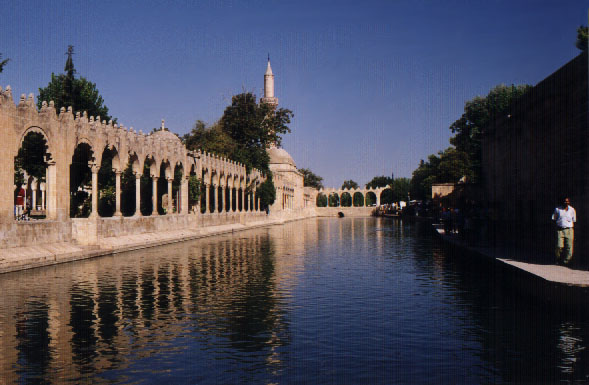 |
| Urfa's famouse Abraham's Pool (Gölbasi) |
We climbed down the plaza towards the entrance of the sacred pool. Passing through an arched stone gate, we reached the heart of Gölbasi. The sacred pool was long and thin, not unlike the Washington Monument's reflecting pool. We walked along its southern edge, cooling off in the shadow of the Abdurrahman Camii, a 17th century mosque with a beautiful 13th century Syrian minaret. The shimmering pool reflected the ornate beige stones of the Rizvaniye Vakfi Mosque and its medieval medresse
The shimmering pool reflected the ornate beige stones of the Rizvaniye Vakfi Mosque and its medieval medresse , which still serves as an Islamic school for young scholars. Crowds of pilgrims congregated along the pool's edge, tossing in handfuls of fish food to satisfy the thousands of carps swimming below them. In contrast to the bustling streets of modern Urfa, Gölbasi was a timeless place of quiet contemplation, where families could peacefully amble along the waterfront and escape the cacophony of the world around them.
, which still serves as an Islamic school for young scholars. Crowds of pilgrims congregated along the pool's edge, tossing in handfuls of fish food to satisfy the thousands of carps swimming below them. In contrast to the bustling streets of modern Urfa, Gölbasi was a timeless place of quiet contemplation, where families could peacefully amble along the waterfront and escape the cacophony of the world around them.
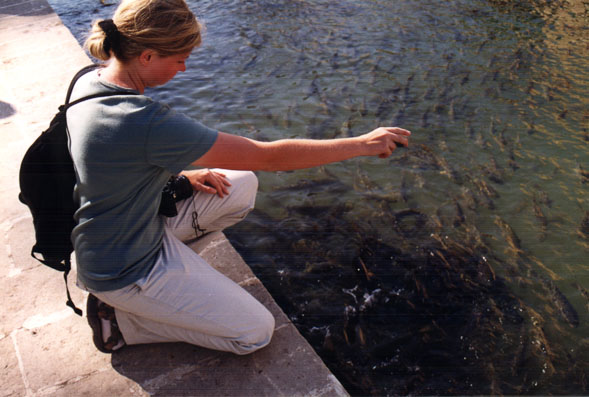 |
| Susanne feeds the sacred carp at Abraham's Pool |
As Susanne and I gazed across the pool, Ali approached us with two small tins of fish food. We took the tins and began to throw pinches of food into the water. The glassy surface of the pool was shattered as thrashing carp targeted each morsel. Wherever I threw the food, the water would dance as more carp whipped themselves into a feeding frenzy. When my tin was empty I visited the food vendor and purchased another round of fish snacks. Özcan, meanwhile, was fending off an aggressive carpet vendor. The broad-shouldered vendor spoke excellent English and was inordinately cocky; he had a very hard time accepting anything short of yes from slim, slight Özcan.
Özcan eventually got the man to leave us alone. "He wants me to take you to his shop in the bazaar, of course," Özcan said, somewhat exasperated. "If we go through there, just ignore him."
The six of us continued along the edge of the pool, occasionally fending off young men who wanted to practice their English and guide us to more carpet shops. Just beyond the far end of the pool we reached Dergah, a complex of gardens and mosques at the center of which lies the Cave of Abraham. According to Islamic tradition, the cave is believed to be the prophet's birthplace. We waited near the center of a large marble courtyard as Özcan went to see if we would be able to visit the interior of the cave. Mid-afternoon prayers were about to begin, and it would be inappropriate for us to enter the mosque once the faithful had arrived.
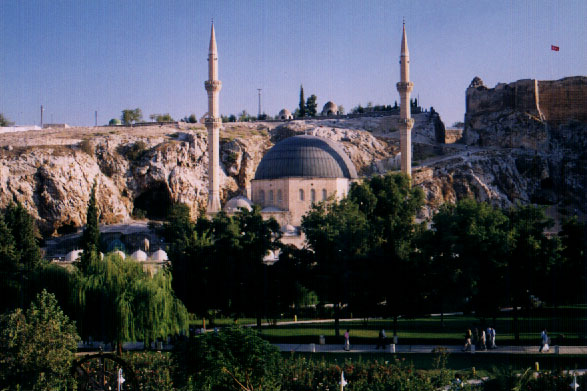 |
| Dergah, one of Islam's holiest pilgrimage sites. The Cave of Abraham is located at the base of the mosque. |
Özcan soon reappeared with two head scarves and a trench coat. "The scarves are for Maggie and Susanne," he said. "You will not be allowed inside unless you cover your head. Michael, you will have to wear the coat if you want to see the cave."
The rest of us did our best not to snicker as Michael climbed into the enormous coat. His bare ankles showing through the bottom end of the coat, he looked like a flasher on the prowl for a bit of naughty fun. Özcan then pointed the four of us to the mosque's two entrances, each one designated by gender. Michael and I entered the cave on the right side, placing our shoes inside wooden cubby holes along the cool stone wall. Directly ahead of us was the small room in which Abraham is believed to have been born. The room was already overcrowded with five or six people, so we crouched through a side door and entered the main room of the adjacent mosque. The mosque was dimly lit, about 25 feet square, and was decorated with thick, red carpets. Woodstained shelves were densely packed with Qu'rans on the far wall. A bearded imam sat in a glass-enclosed compartment, chanting from the Qu'ran while sitting crosslegged among several Ottoman pillows. A pre-teen boy kneeled on a small prayer rug in the center of the room, quietly listening to the imam's hypnotic chanting.
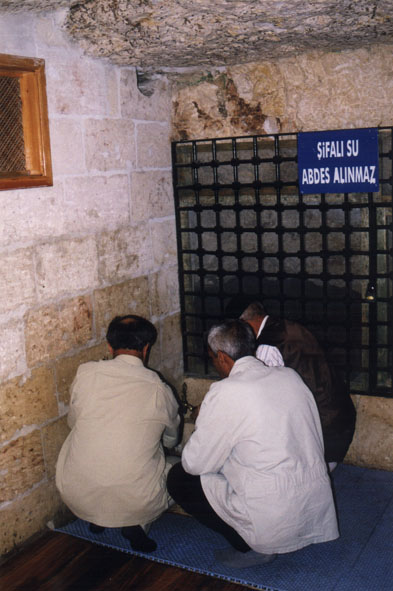 |
Three men sip the sacred
spring waters of Abraham's Cave |
Michael and I did not linger in the mosque, for neither of us wanted to distract the imam and the boy any more than we already had. While Michael exited the mosque I crouched my way to Abraham's birth cave, which was now occupied by only three men. The cave was no larger than a walk-in closest, and only half as tall. Unable to stand up straight I knelt down by the men, who were sharing glasses of water collected from a trickling spring. The spring waters of Abraham's cave are said by some to have healing powers, while others claim that drinking from the spring that once sustained the prophet will bring wisdom and luck. When it was my turn to approach the spring, I ran my hands under the water, cooling my skin. I pressed my damp hands to my forehead and cheeks, wanting to experience the ritual without risking an assault of Urfa's notorious water-borne illnesses. Whether or not this place was truly the birthplace of Abraham, the experience was indeed moving. I could only savor the moment for so long, as several men queued up behind me, patiently waiting their turn at the spring.
The mid-afternoon call to prayer began just as the four of us reassembled by the ablution fountains in front of the mosque. Özcan and Ali led us down the street to Urfa's Kapali Çarsi, or Covered Market. The centuries-old bazaar was crowded with a variety of wholesale shops, peddling goods ranging from carpets and kilims to brasswares and tools. Much of the bazaar was under a series of vaulted ceilings, not unlike the ceilings of the covered market in Istanbul.
"These ceilings have just been restored," Özcan explained. "They now look as new as they once did 700 years ago."
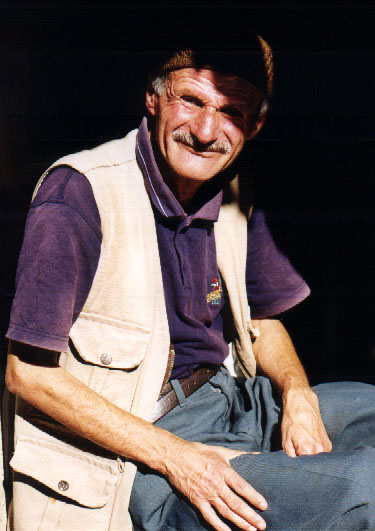 |
| A shop owner inside Urfa's Kapali Çarsi |
As we turned the corner and reached the carpet sellers' market, Özcan noticed the shop that employed the aggressive man we had met earlier near Abraham's Pool. "I know none of you want to buy carpets," Özcan said embarrassedly, "but if I do not at least pretend to bring you there I will have some problems. Just walk through, look around and leave. That will be enough."
Özcan wasn't the sort of guide who enjoyed dragging tourists to unapproved carpet pitches, but clearly his company had a previous relationship with these particular shops. I appreciated Özcan's candor about the situation, for it made it all the easier for us to run the gauntlet of shops. The visit was actually quite painless, for several of the carpet sellers were too busy having lunch with friends. Not one of them pestered us.
Around 3pm we returned to the bus, parked just north of Abraham's pool. While Susanne, Maggie and Michael chatted with Özcan, I joked around with Ali, pointing to different vehicles and teaching each other the words for them in Turkish and English:
"Truck?" I asked.
"Kamyon," Ali replied. "Otobus?"
"Bus. Motorcycle?"
"Motorsikleto."
The interior of the bus had heated up to well over 120 degrees, so we were careful not to touch any metal or hard plastic as we waited for the air conditioning to kick in. Urfa's crowded streets were soon replaced by the endless tobacco fields of the Syrian plain as we drove south to our final destination, the ancient town of Harran.
Harran is one of the oldest continuously-inhabited communities on earth. According to the Bible, it was here in which Abraham lived when God told him to go forth to the land of Canaan: "And I will make of thee a great nation, and I will bless thee, and my thy name great; and though shalt be a blessing..." (Genesis 12:2) Harran was also an important center for the worship of the Assyrian moon god Sin for over 1600 years. During Roman times, Harran became the infamous site of the Battle of Carrae, during which the Roman triumvir Crassus was defeated and killed by the Parthian Persians in 53 BCE. Crassus had sought success on the battlefield as a way of raising his standing among his two competing triumvirs, Pompey and Julius Caesar, but his insufficient and unacclimated forces were unable to withstand the Parthian onslaught. About 350 years later, Roman emperor Galerius was also defeated here by the Persians.
A center of learning and a strategic crossroads along the Syrian branch of the Silk Road, Harran's fortunes ebbed and flowed over the centuries. Today Harran is a small village best known for its beehive houses -- traditional mudbrick structures found nowhere else in Turkey. No public transportation runs directly from Urfa to Harran, so our minibus provided us with a unique opportunity to explore this ancient and unique town.
We drove south towards the Syrian border, following the surging, river-like irrigation channels that pumped over 300 cubic meters of water per second to the local tobacco fields. Turning off the main road just before the border we soon arrived in Harran. At first glance it appeared much like so many other villages in Turkey: unpaved roads, small square houses with clothes lines in the front yards and satellite dishes on the roofs. Near the center of the village we found row after row of Harran's curious beehive houses. The houses were long adobe dwellings with multiple conical roofs made of mud bricks. Some of the homes dated back 200 years, though the majority of them were built in the last century.
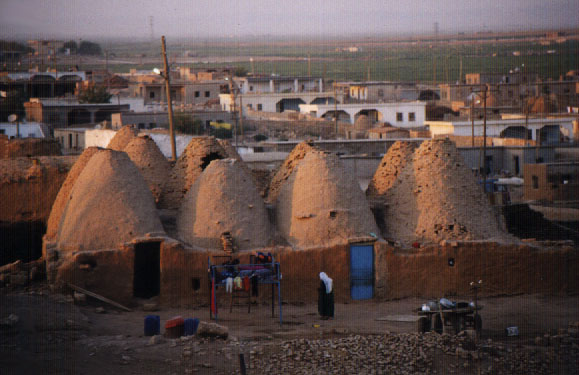 |
| Harran's famous beehive houses, along the Turkish-Syrian border |
Ali parked the bus just outside the Harran Cultural Center, a beehive house converted into a small visitors' center. Though the sun was going to set within the hour, the heat of midday had not subsided. "Same as in Urfa," Özcan said as he closed the bus' front-seat door. "At least 45 degrees centigrade."
Özcan led us into the house and brought us to the living room, situated directly below a beehive roof. The room was typically Turkish, with a red carpet in the center and Ottoman cushions along the perimeter. The mud bricks above us were vaulted into an inverted cone shape, with an open skylight at the very top to allow for ventilation. The room was hot, easily in the 90s, but still significantly cooler than the outside air.
A man entered the living room from the kitchen and greeted us in English. Özcan kissed him on both cheeks and spoke to him in Arabic. The man nodded and smiled before returning to the kitchen to prepare some tea for us.
"So you speak Arabic as well?" I asked.
"Yes, I learned it in the army," Özcan replied. "The people here are Turkish, but they lived in Syria for so many generations they learned to speak Arabic. After the First World War they settled here from Syria, but they continue to speak Arabic, though the children now speak Turkish in school."
The man returned with our glasses of tea, which we all stirred quietly as he and Özcan continued to talk in Arabic. As I sipped my tea it occurred to me that I was sitting inside an unairconditioned building in 115-degree heat drinking piping hot tea, yet hadn't even broken into a sweat. We westerners have a hard time accepting the Arab tradition that drinking hot tea cools the body -- no longer could I question the logic of this practice.
"So you want to try on a costume?" Özcan suddenly interjected. He pointed to a row of several Ottoman sultan and bellydancer costumes that hung along the wall. At first I thought they were there just for display, but I soon realized he was serious. I looked around at everyone else -- Susanne, Maggie and Michael laughed nervously and shook their heads. I began to decline the offer as well until I saw a gold-trimmed sheikh's costume, not unlike the one given to Peter O'Toole in Lawrence of Arabia.
"I'll do it," I said, pointing to the Bedouin outfit.
"Good!" Özcan replied as his friend removed the costume from the wall. The two of them helped me climb into the outfit as the rest of the group -- especially Ali -- burst out into laughter. Ali took the honor of affixing my new khaffiyeh headdress. I looked into a mirror, hoping to see Peter O'Toole gracefully bowing in his splendid Hashemite regalia. I was sorely disappointed.
"I look like such a dork," I said, shaking my head.
"No you don't," Susanne insisted, trying to contain her laughter.
Özcan, meanwhile, had my camera in hand and tried to get a picture of me. For some reason the flash wouldn't go off, so I fiddled with it for a moment and handed it back to him. Again the camera wouldn't work.
"It must be a sign," I said, feeling a little dumb. "Let's never speak of this again."
Özcan gave us a brief tour of the kitchen and its large tandoor oven before we exited the beehive house and walked across the road to the ruins of the local kale. The fortress has probably been in use for several thousand years, but the remaining ruins dated back to the 11th century. As we entered the gate we were rushed by a group of smiling children, all holding out their hands and repeating the phrase, "Bon bon? Bon bon?" Clearly these children were accustomed to tourists coming through and handing out free candy and money, which was unfortunate. We hadn't encountered this kind of begging anywhere else in Turkey, so I was a little troubled by their aggressive behavior. Özcan gave them a few words in Arabic, which most of the kids shrugged off but nonetheless caused them to back off a bit.
The fortress has probably been in use for several thousand years, but the remaining ruins dated back to the 11th century. As we entered the gate we were rushed by a group of smiling children, all holding out their hands and repeating the phrase, "Bon bon? Bon bon?" Clearly these children were accustomed to tourists coming through and handing out free candy and money, which was unfortunate. We hadn't encountered this kind of begging anywhere else in Turkey, so I was a little troubled by their aggressive behavior. Özcan gave them a few words in Arabic, which most of the kids shrugged off but nonetheless caused them to back off a bit.
"This is Harran Kalesi, the ancient fortress of Harran," Özcan said as we mounted the first floor of the structure. "Harran is only a village today, but once it was a great city of scholars. The first Islamic university was built here, though it is long gone. Please take your time and climb to the roof -- from there we will watch the sunset before returning to Urfa."
the ancient fortress of Harran," Özcan said as we mounted the first floor of the structure. "Harran is only a village today, but once it was a great city of scholars. The first Islamic university was built here, though it is long gone. Please take your time and climb to the roof -- from there we will watch the sunset before returning to Urfa."
Susanne and I leisurely explored the ruins as the sun's orange rays bathed its crumbling mud brick walls. Several of the children continued to follow us, curious to see where we'd go next. A beautiful young girl selling handmade necklaces soon appeared from across the village.
"You buy, yes?" she asked.
"No, thank you," Susanne replied kindly.
"Okay," the girl responded, smiling.
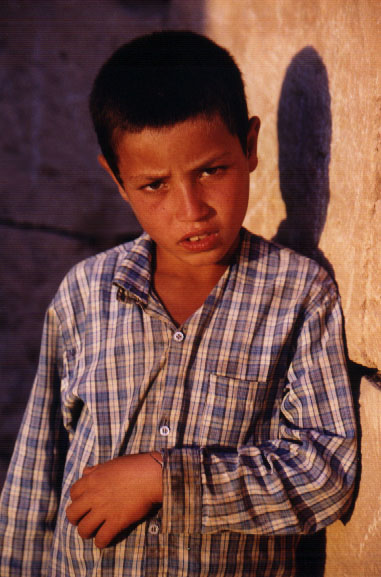 |
| Young boy, Harran |
We climbed to the roof, the children trailing behind us, just as the sun prepared to sail below the horizon. Two of the boys leaned against a mud brick parapet, looking a little bored. I tried striking up a conversation with them in Turkish but they would only respond with more requests for candy and money. The girl, however, was much more eager to chat, and I soon learned that she was nine years old. The boys must have realized that they weren't being very polite, because they soon began to talk as well.
"Kaç yasindasiniz?" I asked them, wanting to know how old they were.
"On iki," one of them replied -- 12 years old.
Özcan, Maggie and Michael soon caught up with us, just as the sun was about to set. "You know," I wondered aloud, "I don't remember the last time I went out of my way to see both sunrise and sunset in the same day."
"Anyone want to do it again tomorrow?" Özcan joked.
"Sure," I replied. "I'll drive."
After making the half-hour ride back to Urfa, we returned to the hotel and had dinner nearby at the Tandir Restaurant. Maggie and Michael again ordered kebaps while Susanne and I fell back on our Turkish pizzas, accompanied by shepherd's salad and a sizable bowl of cacik. As Özcan and Ali chatted with the waiters, the four of us discreetly talked about the best way to tip the two of them. None of us were totally sure what was appropriate, so we settled on $20 per couple.
When we returned to the hotel, we offered the tip to Özcan, who immediately handed the money to Ali.
"Let Ali have it," he said. "I am paid well as a guide. Ali deserves it more than I do."
Just before going to bed, I sat down one last time with Özcan to make arrangements for our trip to Van the next day. While Michael and Maggie would drive onward with Ali and Özcan, Susanne and I would remain in Urfa for another day before catching an overnight bus to Van.
"Before we leave Urfa tomorrow I will pick up your bus tickets and leave them with the hotel," Özcan promised. "I will telephone you that morning and let you know what happened. You can then pick up your tickets at the front desk."
I said my final goodbye to Özcan as we rode the elevator back to our rooms. "Have a safe drive back to Cappadokia," I told him.
"Have a good time in Kurdistan," Özcan replied. "It is very beautiful. You should be safe there."
You should be safe there. The words would echo in my head for days to come.



 he exclaimed. "Hot, very hot...."
he exclaimed. "Hot, very hot...." Turks. Baldwin seized the opportunity and convinced the king to adopt him as his son and heir, to which he acquiesced in a curious ceremony in which Baldwin climbed shirtless into the king's frock and pressed their chests together. To the amusement of the Frankish army, Baldwin repeated the ceremony with the queen. Several days later, Baldwin incited a local mob to lynch the king and queen, then conveniently promoted himself to the throne. Baldwin I, Count of Edessa, thus established the first crusader state in the Middle East.
Turks. Baldwin seized the opportunity and convinced the king to adopt him as his son and heir, to which he acquiesced in a curious ceremony in which Baldwin climbed shirtless into the king's frock and pressed their chests together. To the amusement of the Frankish army, Baldwin repeated the ceremony with the queen. Several days later, Baldwin incited a local mob to lynch the king and queen, then conveniently promoted himself to the throne. Baldwin I, Count of Edessa, thus established the first crusader state in the Middle East.  Once again our meal was preceded with a large platter of shepherd's salad, which was served drenched in some kind of blood-red liquid.
Once again our meal was preceded with a large platter of shepherd's salad, which was served drenched in some kind of blood-red liquid. Urfa's main thoroughfare, Susanne began to snap her fingers with each hand and then slap her hands together, producing a galloping beat. When Özcan noticed what she was doing, his eyes nearly bulged out of his head as he put out his hand to stop her.
Urfa's main thoroughfare, Susanne began to snap her fingers with each hand and then slap her hands together, producing a galloping beat. When Özcan noticed what she was doing, his eyes nearly bulged out of his head as he put out his hand to stop her. which has been used as a natural fortress since Hurrian times. Directly below the limestone bluff is the heart of old Urfa, including its historic bazaar and a maze of important pilgrimage sites honoring the prophet Abraham.
which has been used as a natural fortress since Hurrian times. Directly below the limestone bluff is the heart of old Urfa, including its historic bazaar and a maze of important pilgrimage sites honoring the prophet Abraham. 





